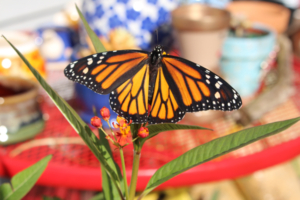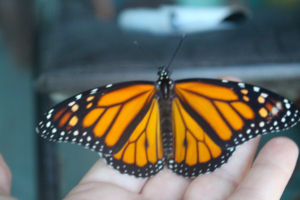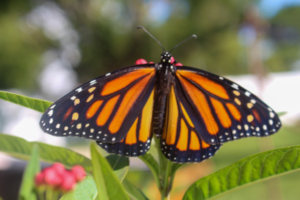Butterfly Daisy helping save Monarchs. One Caterpillar at a Time.
Life Cycle
Monarch butterfly reproduction is a complicated process! It is tied to the migratory patterns of the monarch. In the monarch’s summer territory, which includes most of North America, monarchs will mate up to seven times. Each butterfly lives from two to six weeks. The male courts the female in the air tackles her and breeds with her on the ground. As the monarchs migrate to their summer territory, the female lays her eggs on milkweed plants. The eggs take 3-15 days to hatch into larvae. The larvae feed on the milkweed for about two weeks. At the end of the two weeks, they attach themselves to a twig, shed their outer skin, and change into a chrysalis. This happens in just a few hours! In two weeks, a full-grown monarch emerges!
As fall approaches, non-reproductive monarchs are born. These are the butterflies that will migrate south. They will not reproduce until the following spring. These late summer monarchs travel hundreds and even thousands of miles to their winter grounds in Mexico and California. These monarchs need a lot of energy to make their trip! They store fat in their abdomens that help them make the long trip south and survive the winter. During their five months in Mexico from November to May, monarchs remain mostly inactive. They remain perfectly still hour-after-hour and day-after-day. They live off of the stored fat they gained during their fall migration.
When they first arrive at their winter locations in November, monarchs gather into clusters in the trees. By December and January, when the weather is at its coldest, the monarchs are tightly packed into dense clusters of hundreds or even thousands of butterflies. By mid-February, these clusters of butterflies begin to break up and the monarchs begin to gather nectar. In the spring, they reproduce and their offspring make the return trip to the north.
Diet
Monarch butterfly larva feeds on milkweed. Adults gather nectar from flowers. The monarch is not a very pleasant meal for predators.
Eating milkweed causes the monarch to store alkaloids. This makes it taste horrible to predators! This is such effective protection from predators, the viceroy butterfly has adapted to look like the monarch so predators will leave it alone too!
Habitat
In the spring and summer, the monarch butterfly’s habitat is open fields and meadows with milkweed.
Behavior
The Monarch Butterfly is a long-distance migrator. It migrates both north and south like birds do. But, unlike birds, individual butterflies don’t complete migration both ways. It is their great-grandchildren that end up back at the starting point.
In the fall, monarchs in the north gather and begin to move south. In North America, there are two large population groups that follow separate migration paths. Most monarchs east of the Rocky Mountains overwinter in the Sierra Madres in central Mexico where they live in fir forests at high altitudes. Far western populations of monarchs winter along the coast of southern California where they live in groves of pine, cypress, and eucalyptus trees. In the spring they head north and breed along the way.
Monarch migration back to the north is like a relay race! The original butterfly dies along the way, but the offspring it leaves behind continues on to the north where the cycle will start again in the fall. There are populations of monarchs in California, Florida, and Texas that don’t migrate.
10 FASCINATING FACTS ABOUT BUTTERFLIES
Named for its mostly white marking, when hints of yellow and green like the vegetable, the Cabbage White may not be the most colorful butterfly in your garden or yard, but it is the most common. The male Cabbage White has one prominent black spot on each wing, while the female has two.
Although in many cases cold weather will end the already short life of a butterfly by rendering them immobile, others take the dropping temperature as a signal to move. Butterflies are cold-blooded and require – in ideal settings – a body temperature of approximately 85 degrees to activate their flight muscles. If the weather begins changing some species simply migrate in search of sunshine. Some, like the North American Monarch, travel an average of 2,500 miles!
With a wingspread of between four and seven inches, this species has a name that fits its dimensions. If you have ever seen one on a hike or around your yard, you may have been spellbound by the sight of it. Their swallowtail description is borrowed from birds of the same name, thanks to the long tails on this butterfly’s hindwings.
As we’ve discussed, the lifespan of the average butterfly is short, and even at its peak, these insects are some of the most fragile. Staying alive for as long as possible allows the butterfly additional opportunities to mate, and continuing the existence of its species is of utmost importance. Therefore, butterflies frequently use their wings as a defense mechanism. Either by folding to blend in with their surroundings, or wearing a full spectrum of colors and patterns to frighten predators, a butterfly’s wings are often their best protection.














